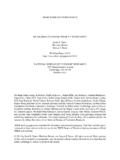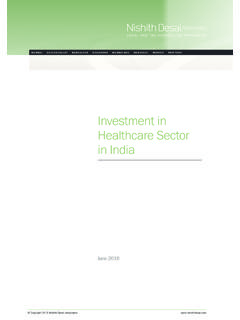Transcription of Investment 2013/01 OECD Working Papers on International
1 Please cite this paper as:Davies, K. (2013), China Investment Policy: An Update ,OECD Working Papers on International Investment , 2013/01 ,OECD Working Papers on InternationalInvestment 2013/01 China Investment PolicyAN UPDATEKen DaviesJEL Classification: F02, F21, F23, F52, F63, G34,L21, L32 OECD Working Papers ON International Investment The International Investment Working paper series including policies and trends and the broader implications of multinational enterprise is designed to make available to a wide readership selected studies by the OECD Investment Committee, OECD Investment Division staff, or by outside consultants Working on OECD Investment Committee projects. The Papers are generally available only in their original language English or French with a summary in the other if available. This work is published on the responsibility of the Secretary-General of the OECD. The opinions expressed and arguments employed herein do not necessarily reflect the official views of the Organisation or of the governments of its member countries.
2 This document and any map included herein are without prejudice to the status of or sovereignty over any territory, to the delimitation of International frontiers and boundaries and to the name of any territory, city or area. Comment on the series is welcome, and should be sent to either or the Investment Division, OECD, 2, rue Andr Pascal, 75775 PARIS CEDEX 16, France. OECD Working Papers ON International Investment are published on: OECD 2013 Applications for permission to reproduce or translate all or part of this material should be made to: OECD Publishing, or by fax 33 1 45 24 99 30. * This report was written by Ken Davies (Consultant for the OECD Investment Division). It also benefited from comments by Michael Gestrin and Andrea Goldstein (OECD Investment Division). To contact the author, email: Further information on Investment for Investment work at the OECD may be found at Abstract CHINA Investment POLICY: AN UPDATE By Ken Davies* This Working paper examines China s Investment policy since the publication of the 2008 OECD Investment Policy Review of China.
3 China remains the largest recipient of FDI among developing countries and FDI continues to play a disproportionately large role in promoting China s trade, Investment and tax revenue generation, albeit not as large as before. A number of structural changes occurred in recent years, including a slight revival of equity joint ventures, faster growth in services-sector FDI than in manufacturing, and a reorientation of FDI from the Eastern Region to the Central and Western Regions. In addition, China has been rapidly becoming an important source of outward foreign direct Investment (OFDI), a trend that was reinforced by the global financial and economic crisis. While foreign investor confidence is maintained by China s economic strength, it is being undermined by rising labour costs and shortages of skilled labour and by greater competition (especially from Chinese companies). In addition, there are fears that an Investment protectionist trend may be emerging in China, as evidenced by, for example, perceived discrimination against foreign-owned companies in government procurement.
4 The Chinese government has taken a number of measures to streamline and decentralise FDI administration and strengthen enforcement. The emphasis has been on aligning inward FDI flows more closely with national priorities, including upgrading industrial sophistication, supporting innovation, setting up outsourcing industries and developing poorer hinterland regions. The most important change is the three-fold raising of the ceiling on provincial examination and approval authority over foreign Investment projects in the permitted catalogue . Merger notification discrimination against foreign investors has been removed and a national security review process for cross-border M&As has been announced. The Chinese government should continue its efforts to liberalise and increase the transparency and predictability of the framework for both inward and outward FDI. JEL Classification: F02, F21, F23, F52, F63, G34, L21, L32 Keywords: China; foreign Investment ; International Investment ; level playing field; International Investment agreements; Investment treaties; bilateral Investment treaties, state-owned enterprises.
5 5 TABLE OF CONTENTS EXECUTIVE SUMMARY .. 7 THE FOREIGN Investment CLIMATE IN CHINA .. 10 Recent trends in foreign direct Investment (FDI) inflows to China .. 10 Developments in government policies towards foreign Investment since 2008 .. 20 The 2011 Foreign Investment Industrial Guidance Catalogue .. 28 Lessons from recent foreign investor experiences in China .. 29 There has been some progress on IPR protection, but more efforts are needed .. 32 The FDI policy framework has improved, but remains restrictive .. 33 RECENT DEVELOPMENTS IN CHINA S OUTWARD FDI POLICIES .. 34 OFDI by provincial-level units varies widely .. 42 Divergent local policies towards outward FDI are starting to become apparent .. 43 CONCLUSION AND POLICY IMPLICATIONS .. 56 The inward FDI regime can be further liberalised .. 57 The go global policy has been successful .. 57 Greater transparency at central level can help maintain rapid OFDI growth .. 58 Provinces can benefit from greater policy and data transparency.
6 59 GLOSSARY .. 61 ANNEX 1 STATISTICAL TABLES .. 70 7 EXECUTIVE SUMMARY While China remains the largest recipient of FDI among developing countries. FDI inflows are no longer an increasing contributor to the country s trade surplus, industrial output, fixed Investment or tax revenues. This is mainly due to dynamic GDP growth, but also to a more selective though still open policy approach. Nevertheless, FDI continues to play a disproportionately large role in promoting China s trade, Investment and tax revenue generation, albeit not as large as before. A number of structural changes occurred in recent years. The first one concerns the form of entry. While wholly-foreign-owned enterprises became the dominant form of inward FDI in China, there has been a slight revival of equity joint ventures. Earlier ownership forms like contractual joint ventures, which were introduced in the early 1980s as an initial entry method for FDI designed to allow foreign participation in the economy while limiting foreign control of enterprises, have meanwhile dwindled to insignificance.
7 The second change concerns the industrial classification. Services-sector FDI is now growing faster than FDI in manufacturing. As China becomes richer and a middle class emerges, foreign investors are attracted to the domestic market. In addition, as wages have begun to rise steadily in the country s export manufacturing centres in the eastern coastal region, other countries have become more competitive than China in labour-intensive industries. At the same time, wage and other upward cost pressures have started to do what the government s regional policy had previously found difficult: shift economic growth westward from the Eastern Region to the Central and Western Regions. For much of the reform period, GDP growth was fastest in the Eastern Region, driven by the growth of export industries and infrastructure construction. In the 2000s, a policy of investing in hinterland Investment construction initially failed to attract Investment from outside. More recently, FDI has started to grow more rapidly in the Central and Western Regions.
8 Nevertheless, in the most recent year for which figures have been published, 2010, the Eastern Region continued to absorb the overwhelming majority of foreign Investment by number of projects and utilised foreign Investment value. While foreign investor confidence is maintained by China s economic strength, it is being undermined by rising labour costs and shortages of skilled labour and by greater competition (especially from Chinese companies). In addition, there are fears that an Investment protectionist trend may be emerging in China, as evidenced by, for example, perceived discrimination against foreign-owned companies in government procurement. 8 China is not a member of the WTO Government Procurement Agreement (GPA), so it does not have to open its government procurement to companies outside China, though it is currently in the process of submitting a third application to join the GPA. This is fundamentally a trade issue. It becomes, however, an Investment issue if the government discriminates in favour of Chinese-owned companies in disregarding or downgrading bids from foreign-invested enterprises based in China and incorporated under Chinese law.
9 Such discrimination has taken place as part of China s indigenous innovation policy , which until recently giving preference to domestic companies using new technology. This policy has now been dropped. In January 2011, it was announced in a joint US-China statement that China will not link its innovation policies to the provision of government procurement preferences. 1 It remains to be determined to what extent the policy has now changed sufficiently to provide a level playing field for domestic and foreign-invested enterprises bidding on government contracts. The Chinese government has taken a number of measures to streamline and decentralise FDI administration and strengthen enforcement since the publication of the 2008 OECD Investment Policy Review of China. The emphasis has been on aligning inward FDI flows more closely with national priorities, including upgrading industrial sophistication, supporting innovation, setting up outsourcing industries and developing poorer hinterland regions.
10 The most important change is the three-fold raising of the ceiling on provincial examination and approval authority over foreign Investment projects in the permitted catalogue . Merger notification discrimination against foreign investors has been removed and a national security review process for cross-border M&As has been announced. China has been rapidly becoming an important source of outward foreign direct Investment (OFDI) in recent years, a trend that was reinforced by the global financial and economic crisis. The go global policy encouraging OFDI by Chinese enterprises has been strengthened and further elaborated since the 2008 Review. As with previous Five Year Plans, it continues to be stressed in the current Five-Year Plan for 2011-2015, both directly and as part of the policy of promoting national champions. The government is gradually lightening the administrative burden on enterprises applying for examination and approval before investing abroad, though the process still involves much red tape, as described in the 2008 Review.

















